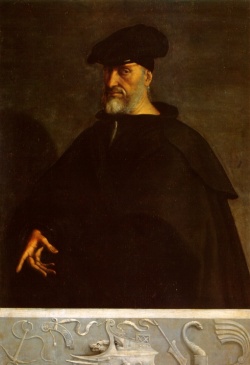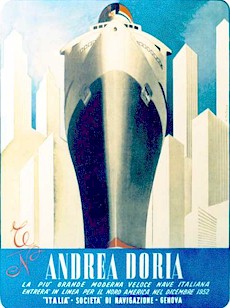Andrea Doria
|
| Eric Sauder [T.H.S.] Collection: The Andrea Doria was justifiably considered to be the most beautiful ship of the postwar era. |
 |
Sebastiano del
Piombo (Sebastiano Luciani) |
Genoa, the home port of this ship, produced two of the world's greatest sea captains: Christopher Columbus and Andrea Doria. While Columbus went off in search of new sea routes and new worlds, Doria stayed home and fought off in turn the Spanish, the French and Barbary pirates. One of the most wily fighting men and politicians of his day, Andrea Doria, who is credited as the first man to discover how to sail against the wind, became Admiral of the Genoese Fleet and "Father of his country". Like that of the Borghese, the name of Doria lived on through the centuries as one of the great family names of Italy and it was to Andrea Doria that the Italian Line returned when choosing a name fitting for the great ship it had designed after the second World War.
![]()
(Some of the following excerpts are from the book "Lido Fleet" by Peter C. Kohler)
The keel of the Yard No. 918, was laid on the No. 1 slipway at Ansaldo's Sestri Ponente yards on February 9th, 1950. On May 22nd, 1951 the New York Times reported on the progress of the construction.
Towering almost one hundred feet above the suburb of Sestri Ponente, the 637 foot long hull is visible for miles, and the red bottom, surmounted by many feet of black painted steel, lends color to this otherwise drab and dreary part of Genoa's port, from which the new liner, flying the flag of the Italian Line, will depart regularly next year. A visit to this birthplace of such famous ships as the Rex, the Roma and the Augustus, well remembered in prewar days, is a noisy one. The sight of the huge sides of the nearly completed ship set off by countless squares of scaffolding is embellished by the beats of riveting hammers, the pounding of twenty-pound sledges.
To the whining of electric motors, large prefabricated pieces weighing as much as four tons, slide down to the construction site, traveling approximately 300 yards from the assembly area to a point directly above the precise spot where they are to be installed in the hull by one of 2,000 construction workers.
 Planned for June 10th, 1951, it was six days later
when, blessed by His Eminence Cardinal Siri, Archbishop of Genoa, and christened Andrea
Doria by Signora Giuseppina Saragat, wife of the former Minister of the Merchant
Marine, Italy's first postwar North Atlantic liner slid down the Ansaldo ways. By the
23rd, she was in the fitting-out basin and expected to be ready "by next
summer". Decorating the interior of this ship consumed another eighteen months and on
November 6th, 1952 Andrea Doria left Sestri Ponente for her preliminary engine
trials. Nine days later, amid reports of machinery problems, her maiden voyage was
rescheduled from December 14th, 1952 to January 14th, 1953.
Planned for June 10th, 1951, it was six days later
when, blessed by His Eminence Cardinal Siri, Archbishop of Genoa, and christened Andrea
Doria by Signora Giuseppina Saragat, wife of the former Minister of the Merchant
Marine, Italy's first postwar North Atlantic liner slid down the Ansaldo ways. By the
23rd, she was in the fitting-out basin and expected to be ready "by next
summer". Decorating the interior of this ship consumed another eighteen months and on
November 6th, 1952 Andrea Doria left Sestri Ponente for her preliminary engine
trials. Nine days later, amid reports of machinery problems, her maiden voyage was
rescheduled from December 14th, 1952 to January 14th, 1953.
On acceptance trials from 3-9 December over the Portofino-Chiappa measured mile, Andrea Doria maintained a speed of 25.3 knots for six hours with a top speed of 26.218 knots. Any earlier defects had been corrected and her performance was eminently satisfactory. Andrea Doria returned to Genoa at 11:20pm on the 9th and was formally handed over on the 19th, one of the proudest days in Italia's history. The Italian Line in designing this ship which was to mark the rebirth of the Italian merchant marine after the second World War, decided wisely not to compete with the United States and Britain for size and speed of their ships. Instead the Andrea Doria was imbued with Italy's matchless heritage of beauty, art and design. The 29,083 gross ton ship, 696.5 feet long and 89.9 feet wide, of course was no slowpoke midget. She was among the fastest ships in the world. The Andrea Doria had the capacity of 218 First Class, 320 Cabin Class, 703 Tourist Class passengers and 563 Officers and crew.
On January 14th, 1953 the Andrea Doria began her maiden voyage and was given one of Genoa's most heartfelt send-off. Named after the ports favorite son and built by local shipwrights, Andrea Doria was more than a line and national flagship; she belonged to every Genoese. The city, laid out like an amphitheater around the port that gave it wealth and power, was the setting for her 11:25am departure. Every quay, breakwater and coastal road was thronged by cheering spectators and Ansaldo shipyard workers paused from building her sister ship to salute their creation's maiden voyage.
As beautiful as it was, the Andrea Doria is said to have a curse. Many serious accidents happened in the shipyard and when the Andrea Doria and the Conte Biancamano saluted each other in Naples by blowing their whistles, the Andrea Doria's whistle got stuck. It could not stop blowing and it became a bad omen for some.
Most of the crossing was enjoyed in fine weather, but conditions quickly deteriorated as Andrea Doria made her final approach to New York. What Captain Calamai characterized as one of the worst storms in his 35 years at sea, started at 5:00am on January 22 with 45 mph winds and heavy seas and reached its peak at 2:00pm with Force 9 winds.
 Despite the storm, the ship was only minutes late arriving
at New York early on January 23rd. The welcoming delegation, which included New York Mayor
Vincent R. Impellitteri, boarded off Quarantine. With the U.S.S. Osberg leading the
escort, Andrea Doria triumphantly steamed into the harbor and docked at Pier 84
just after 10:00am.
Despite the storm, the ship was only minutes late arriving
at New York early on January 23rd. The welcoming delegation, which included New York Mayor
Vincent R. Impellitteri, boarded off Quarantine. With the U.S.S. Osberg leading the
escort, Andrea Doria triumphantly steamed into the harbor and docked at Pier 84
just after 10:00am.
Additional Pictures: Click on the image to enlarge it.
     |
| Left to Right: First Class Hallway, Dining Room, Bar, Ballroom & Lounge |
    |
| Left to Right: Cabin Class Bar, Ballroom, Card Room & Reading Room |
![]()
Stockholm

A portrait of the yacht-like Stockholm, built in 1948, as she looked with her enlarged superstructure of 1953.
The Stockholm was the first new passenger ship to cross the North Atlantic after the second World War. She was the largest ship ever built in Sweden but at the same time was the smallest passenger liner in the North Atlantic trade. The Swedish-American Line in 1953 had the Stockholm's superstructure enlarged to increase its passenger capacity from 395 to 548. The ship still retained the sleek appearance of a racing yacht. She was 525 feet long, 69 feet at the beam, with a long forecastle, severely raked destroyer bow and gracefully rounded cruiser stern As her owners pointed out, the Stockholm was a ship built for comfort rather than luxury.
| Stockholm profile diagram. |
![]()
Ile de France

The Ile de France
Launched in June, 1926 the Ile de France was one of the largest and fastest ships in the world. Year after year she maintained her renown as one of the most pleasant, comfortable and fun-loving ships afloat. She served six years through the second World War and carried 626,000 troops safely to all parts of a world torn by war. After the war, the 44,500 ton ship returned to her original shipyard in St. Nazaire, France. She was completely overhauled and outfitted in 1949 and once again sailed as a testament to the French concept of gracious living.
| Ile de France leaving New York |







